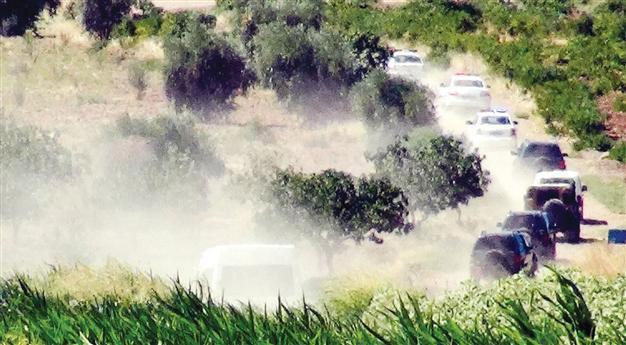No-fly zone over Syria is on the table
MURAT YETKİN

Gen Hayri Kıvrıkoğlu, commander of Turkish Land Forces, and accompanying military members travel to the Turkish-Syrian border to inspect the border troops. DHA photo
Forming an international coalition to impose a partial no-fly zone over Syria, in order to provide protection for the Syrian population on the run from the civil war ongoing in the country, has been under discussion among Western allies for the last few weeks, Turkish official sources confirmed to the Hürriyet Daily News on Aug. 24. The confirmation came after French Defense Minister Jean-Yves Le Drian had earlier told the France 24 television station that France was considering supporting the idea.
The confirmation also coincided with updated figures from AFAD, the Turkish disaster control agency under the Prime Minister’s office, which showed that the number of refugees from Syria was now nearly 80,000. This figure approaches the 100,000 threshold that Turkey could afford within its national resources, as revealed by Foreign Minister Ahmet Davutoğlu earlier in the week to daily Hürriyet newspaper.
The issue was among the scenarios considered during talks between Turkey and the United States held in Ankara on Aug. 23, according to diplomatic sources speaking to the Daily News on condition of anonymity. This “first operational meeting,” as the Turkish Foreign Ministry described it, regarding post-Assad scenarios in Syria was at the technical level, with diplomats, military and intelligence officers all taking part.
U.S. State Department spokesperson Victoria Nuland had told reporters in Washington D.C. after the meeting that they were “looking at very feasible options” with “not just Turkey, but all of our allies and partners. We are obviously doing the appropriate thinking and contingency planning, in case we confront a situation where al-Assad makes a terrible and horrific choice.”
The meeting had been agreed on during the talks between U.S. Secretary of State Hillary Clinton and her Turkish host Davutoğlu in Istanbul on Aug. 11. Following the Istanbul talks, Clinton had said that they were looking for new ways to pressure the Bashar al-Assad regime in Syria, after his allies Russia and China blocked consecutive actions at the U.N. Security Council. Diplomatic sources told the Daily News that the no-fly zone issue had been discussed, not only between Davutoğlu and Clinton, but also with French Foreign Minister Laurent Fabius during his visit to Ankara and the Turkish border town of Kilis, where a number of Syrian refugees are staying, on Aug. 17. Fabius also indicated separately in a press conference that France was weighing up the possibility of a no-fly zone.
Turkish official sources recalled that a similar international coalition had been formed in 1991 by the U.S., the U.K., and France, to impose a partial no-fly zone to provide safety for possible refugees from attacks by Saddam Hussein’s forces in Iraq, without a U.N. Security Council resolution. The zone in the north had been operated from Turkish soil, and was flooded by some 600,000 Kurdish refugees at the time.
